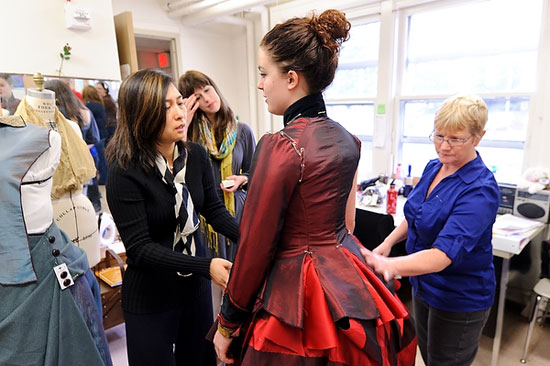UW Opera costume designers make good singers look great

Costume designers Sydney Krieger (right) and Hyewon Park (left) work on the fit of a costume worn by University of Wisconsin–Madison undergraduate Caitlin Miller (center) for the upcoming UW Opera performance of “La Boheme.” Also pictured is undergraduate Katherine Peck (center left).
Photo: Bryce Richter
Sophomore Caitlin Miller stands in the middle of the room in a deep red outfit, richly detailed with lace trim and swags of striped fabric. Under her costume, she wears a corset tied just tight enough to allow proper breathing. That’s crucial for a singer, especially one standing under hot stage lighting — or the fluorescent glow of the costume shop — for hours at a time.
Costume designer Sydney Krieger asks Miller to raise her arm, checking the movement of a sleeve.
“How much? I have to motion up at one point,” says Miller, assuming a pose like the Statue of Liberty.
“No woman of that period would have raised her arms above her bosom,” replies Krieger. “Drinking a cup of tea, maybe.”
Welcome to the UW Opera costume shop, where fashion history, stage blocking, vocal technique, sewing mastery and tight budgets come together in an ever-moving buzz.
Since meeting in UW–Madison’s MFA program in the late 1990s, Krieger and co-designer Hyewon Park have outfitted hundreds of singers in styles from ancient Roman to Eurotrash goth. Though not permanent employees, they have returned year after year to give a welcome sense of stability to the program.
Unlike most opera companies — professional or amateur — UW Opera plans each season nearly two years in advance. With a rotating roster of singers each year, not to mention a tiny stage, staff and production area, planning is crucial. This October’s production of Puccini’s La Boheme has a traditional look and a large cast, including several children.
“This opera is traditionally set in the 1840s or early 1850s, but we’re bumping it up to the 1880s,” says Krieger. “We have a very small stage, with 35 people in the cast. So if everybody had hoop skirts, we wouldn’t all fit.”
Because of their close relationship with UW Opera director William Farlow, Krieger and Park have major input on the way a production takes shape. Farlow came to the university just as Krieger and Park began their professional partnership.
“I knew these were perfect designers for me,” says Farlow. “They not only had the technical capabilities, but could do everything else that they don’t have to do out in the ‘civilized world’ — design and build costumes, run the shop, do wigs and makeup. What they get here is huge input into the approach to the production. They are given a huge realm of possibilities of what to do artistically.”
In the early stages of a project, Krieger and Park ask themselves what they may need to build from scratch and what they can procure from other sources. With their limited budget, they make ample use of technical wizardry, refashioning existing pieces to make them reflect fashions hundreds of miles or years apart.
“They’re great about prioritizing,” says Farlow. “They’ll say, ‘This is the most important thing to me; is it the most important thing to you?’ Besides being wonderful artists, they’re both very practical. That’s a rare combination.”
Miller, playing the coquettish Musetta, wears a typical ensemble that combines pieces from several sources. The skirt, designed by Krieger, came from a previous production set in the 18th century; the bustle came from Children’s Theatre of Madison. The skirt’s original bodice belied the time period, so Miller stands patiently as three women pin sleeves onto a newly constructed jacket.
“We don’t know what we can do until the fittings,” says Park. “That’s part of the magic that happens here. We’ve gotten adept at double duty.”
“Double duty” has multiple meanings in the costume shop. Like most UW Opera productions, La Boheme uses double casting to give more singers the experience of singing principal roles. Sopranos Megan Gryga and Shannon Prickett, sharing the lead role of Mimì, will wear a skirt built to fit both of their figures. Because the period style requires closely fitted lines, however, each singer will wear her own matching jacket.
For all their own skills, Krieger and Park plan their costumes based on the skills of their biggest supporters: the singers themselves. Today Gryga, a senior, pleats fabric for the back of her skirt; sophomore Erik Larson machine-sews a tweed vest for his sergeant’s outfit. He pulls it away from the table and surveys his work.
“Hey, you did it!” says Park. “Had you ever sewn before?”
“I think I made a pillow in eighth grade,” says Larson, grinning with pride.
Farlow considers it critical to involve the students at every point of the production. Space limitations force the singers to rehearse as the sets are literally constructed around them, but the familiarity means that the performers don’t need to adjust their movements once tech week arrives. Similarly, the care they put into creating parts of their own costumes — and wearing them during rehearsals — gives them an appreciation for the costumers’ hard work.
Despite the number of tasks and the need to supervise inexperienced workers, Krieger and Park take pride in each tiny detail. A test piece of trim reveals three layers of fabric and cord, with an edging of less than one-fourth inch peeking out between two shades of red. The inner layer of Miller’s new jacket, black with a floral brocade, looks as tidy as the outside.
“It’s just a lining, but we try to make everything beautiful,” says Park. “There’s a chance we might use it reversed! Who knows?”
This level of detail illustrates the thought that goes into each production. Farlow notes how much time and energy he saves because of his familiarity with the designers. As a complementary team, the strengths each designer brings help him do his own job better.
“Sydney and Hyewon are extraordinary at helping me shape ideas,” he says, describing a head-turning production of Mozart’s Don Giovanni several years ago. “I brought a more skewed, exaggerated version; they were able to give me everything I wanted, but in a more flexible format. That’s what they do. It ended up focusing my concept and channeling it to a greater degree.”
Asked to summarize his working relationship with the designers, the usually voluble Farlow pauses to find the right words.
“Happiness,” he says, finally, with a certain reverence. “And joy. It really is a joy working with them. I can’t say that about everything I do.”
Tags: arts

